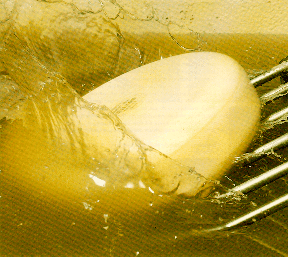 < Cheeses in single file taking the plunge into the brine-bath.
< Cheeses in single file taking the plunge into the brine-bath.

Cheese is made by curdling the milk. The homogeneous fluid changs into a mixture of solid particles and a pale yellow liquid. These are seperated and the solid elements make up the curd. The residual fluid is called whey.
 < Cheeses in single file taking the plunge into the brine-bath.
< Cheeses in single file taking the plunge into the brine-bath.
The curd is pressed into moulds, after which the cheese goes into a brine bath for several days. Subsequently it is stored and thus gradually matures into the delicious product we can buy in the shops.
Through the centuries numerous versions to the cheese making process were
found resulting in many hundreds of regional varieties.
The major difference between farm and creamery cheese is their starting ingredient, the milk. On the farm raw milk, which is the cooled milk of the previous evening and the milk, still warm from the morning's milking, is the basis.
At the creamery the milk is first pasteurised, which means that it is heated to a temperature of about 65 degrees Celcius for fifteen seconds thus eliminating any bacteria. The second difference is that the milk is standardized, in other words the fat content of the milk is constant. On the farm the fat content may vary.
A third difference between farm and creamery is that on the farms cheese making is still a craft and made by hand. Cheese making in the creamery is a highly automated production process, during which the cheese is not handled. Moulding, turning, brining, is all completely computerised. Gigantic robots, moving independently, transport the cheese in and out of the warehouse. Modern creameries produce daily some 5,000 cheeses each weighing between 2 and 15 kilos.

In addition to official inspections, Dutch cheese is subject to further
tests. Cheese Quality Managers and Traders regularly take samples to judge structure
and taste. They smell, feel and taste. The best cheeses are entered into
competitions where the honour of the creamery and its Cheese-Maker are at
stake. Producers and Traders also participate in the annual contest for
`Gold Cheese Scoop', a trophy for the best Cheese Quality Manager.
 Every cheese is given a control stamp with its own number. >
Every cheese is given a control stamp with its own number. >
In the past low-fat cheese was sold as `full cream' cheese. This dates back
to
the sixteenth century
when the States General of Holland issued a decree
regarding cheesemaking,
`The degree touching on the falsifying of Sweet Milk and Cheese made thereof'.
The emphasis was put on the fat content of the cheese.
Nowadays, we have the
control stamp which gives the fat content, cheese type and a number indicating
batch and creamery. It also indicates the cheese complies with all statutory
regulations.
Gouda cheese contains, on average, 40% water and 60% `dry matter'. When the fat content in the dry matter is at least 48%, which is the legal requirement for Gouda cheese, we speak of full-cream cheese.
Edam cheese, which is made from skimmed milk, has a fat content of 40% in the dry matter. There are other cheeses with fat contents varying from 20% to 60%.